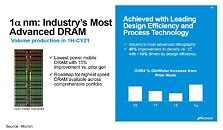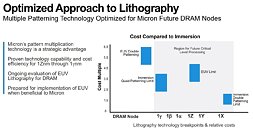TheLostSwede
News Editor
- Joined
- Nov 11, 2004
- Messages
- 18,229 (2.46/day)
- Location
- Sweden
| System Name | Overlord Mk MLI |
|---|---|
| Processor | AMD Ryzen 7 7800X3D |
| Motherboard | Gigabyte X670E Aorus Master |
| Cooling | Noctua NH-D15 SE with offsets |
| Memory | 32GB Team T-Create Expert DDR5 6000 MHz @ CL30-34-34-68 |
| Video Card(s) | Gainward GeForce RTX 4080 Phantom GS |
| Storage | 1TB Solidigm P44 Pro, 2 TB Corsair MP600 Pro, 2TB Kingston KC3000 |
| Display(s) | Acer XV272K LVbmiipruzx 4K@160Hz |
| Case | Fractal Design Torrent Compact |
| Audio Device(s) | Corsair Virtuoso SE |
| Power Supply | be quiet! Pure Power 12 M 850 W |
| Mouse | Logitech G502 Lightspeed |
| Keyboard | Corsair K70 Max |
| Software | Windows 10 Pro |
| Benchmark Scores | https://valid.x86.fr/yfsd9w |
Although Micron is a predominantly US company, it also has some fabs in Japan, Singapore, the PRC and Taiwan, many of which became part of Micron after it bought other companies. Based on Micron's Computex presentation, it's getting ready to upgrade one of its three fabs in Taichung with extreme ultraviolet (EUV) lithography technology later this year. This is in preparation for the company to move to what it calls its 1-gamma process node for DRAM. Initially this seems to be a R&D node to help the company prepare for a wider rollout of EUV technology. Micron's current DRAM is based on its 1-alpha node and it's planning to move its 1-beta node into volume production next year, in its Taiwan fabs.
Micron's current 1-alpha node is based on DUV technology and was introduced last year, with the company claiming it had a 40 percent improvement in memory density over its previous 1Z node. Micron no longer mentions its die size in the commonly used nanometer measurement, but its 1Z node is said to have been around 11 to 13 nm, so it's likely that the 1-beta node will end up below 10 nm, if its 1-alpha node isn't already below 10 nm. Micron's longer term roadmap also includes a 1-delta node, which was meant to be its first EUV product, but this now seems to have been moved forward to its 1-gamma node. It's likely that Micron will be moving its other fabs to EUV in due time as well, but DRAM has so far not benefitted as much from node shrinks compared to most other types of integrated circuits, so it'll be interesting to see what gains EUV might bring.


View at TechPowerUp Main Site | Source
Micron's current 1-alpha node is based on DUV technology and was introduced last year, with the company claiming it had a 40 percent improvement in memory density over its previous 1Z node. Micron no longer mentions its die size in the commonly used nanometer measurement, but its 1Z node is said to have been around 11 to 13 nm, so it's likely that the 1-beta node will end up below 10 nm, if its 1-alpha node isn't already below 10 nm. Micron's longer term roadmap also includes a 1-delta node, which was meant to be its first EUV product, but this now seems to have been moved forward to its 1-gamma node. It's likely that Micron will be moving its other fabs to EUV in due time as well, but DRAM has so far not benefitted as much from node shrinks compared to most other types of integrated circuits, so it'll be interesting to see what gains EUV might bring.


View at TechPowerUp Main Site | Source


 Xi Jingping happy: "See, this is why capitalism is failing."
Xi Jingping happy: "See, this is why capitalism is failing."
